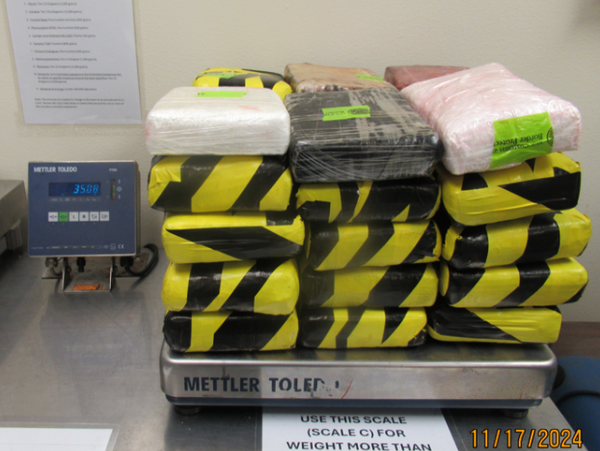/shutterstock_1606529806.jpg)
Nvidia (NVDA) stock has dropped from its recent high of $504.09 on Nov. 20 after its blowout Q3 results. At $475.06, its close on Friday, Dec. 8, NVDA stock is just above its average trading range. This is ideal for put option short sellers who follow this strategy as an income play.
I discussed Nvidia's huge potential upside in my recent Barchart article on Nov. 26, “Nvidia's Blowout Quarterly Results Imply NVDA Stock Could Be Worth Over $700 Per Share.” It led me to the conclusion that NVDA stock could reach over $730 per share in the next year.
FCF Can Power NVDA Stock Much Higher
Here is a summary of how I reached that target price. First, I pointed out that its free cash flow (FCF) for the nine months ending Q3 was $15.7 billion, representing 40.5% of its $38.8 billion in Q1-Q3 total sales.
For the most recent quarter, it generated $7 billion in FCF on $18.8 billion in sales. That represents a similar FCF margin of 38.8%.
That YTD 40.5% FCF margin is extremely high. It means that after all its cash expenses, including all its capex spending and working capital needs (not on the income statement), the company still had 40% of its revenue available for discretionary uses.
This cash flow is “free” to be spent on dividends, buybacks, acquisitions, or accumulate in their checking account. Since Nvidia's dividend is very small (just 16 cents per share annually), it costs the company only $100 million out of the $15.8 billion in FCF it generates. The company spent only $3.8 billion of its $7 billion in quarterly FCF on buybacks.
That means the rest of the cash flow is piling up on the balance sheet. Its cash and securities balance rose by $2.258 billion, rising from $16 billion in Q2 to $18.28 billion at the end of Q3.
In other words, Nvidia's FCF not only is powering huge buybacks but it is also increasing the company's checking and investment account coffers. These two factors alone can push NVDA stock higher.
FCF Yield Metric Implies a $745 Price Target
But a second reason why NVDA stock could rise is based on an FCF yield metric. For example, if we assume that the company paid out all of its FCF as dividends, the stock would likely have at least a 2.0% dividend. That is what analysts call an FCF yield metric. This is significantly higher than its present dividend yield of 0.03% (i.e., $0.16/$475.06).
So, for example, if we use analysts' revenue estimates next year of $89.98 billion (based on Seeking Alpha's survey of 54 analyst estimates), we can apply its FCF margin to estimate its free cash flow next year. That means multiplying $90 billion (rounding up) by 40%, which equals $36 billion in projected FCF next year.
So, if we divide this $36 billion FCF estimate by 2.0% (i.e., the FCF yield metric), we get a market cap target value of $1,800 billion (i.e., $1.8 trillion). That is 53.8% higher than its market cap today of $1.17 trillion (i.e., $1.8 tr/$1.17 tr -1 =+0.538).
In other words, NVDA stock could rise 53.8% to $730.64 per share. That means as long as the company is generating similar FCF margins shareholders can expect a huge upside in NVDA stock.
One way existing shareholders can play this while waiting for the stock to rise is to sell short out-of-the-money put options for extra income.
Shorting OTM NVDA Put Options for Income
For example, look at the Dec. 29 option expiration period, which is just 3 weeks away. It shows that the $450 strike price puts, which are $5.28% below today's (Friday Dec. 8) price of $475.06 - i.e., out-of-the-money (OTM), are very attractive.
They are priced at $4.40 per put premium on the bid side (i.e., the short seller will receive $4.40 in premium for every put contract they sell short at the $450 strike price). That represents an immediate yield of 0.98% or almost 1.0% with just 3 weeks to go until expiration.

In effect, if that yield play can be repeated over the next year (i.e., 17 times in a row), the annualized expected return for the short seller is 16.6% (i.e., 0.98% x 17). That yield would be on top of any upside that the stock has as pointed out above. This assumes, however, that the stock never falls to the strike price and always stays out of the money. That may not always happen, so it is best to be careful about choosing the OTM strike price levels.
Nevertheless, the premium received provides extra downside breakeven protection. For example, in this case, the $4.40 in premium received lowers the breakeven level to $445.60 (i.e. $450-$4.40). That means there is effectively a 6.20% downside breakeven level before the short put seller has to incur an unrealized loss.
The bottom line is that NVDA has a good upside potential for shareholders - as much as $730 per share, especially for those existing investors that short its OTM puts.
On the date of publication, Mark R. Hake, CFA did not have (either directly or indirectly) positions in any of the securities mentioned in this article. All information and data in this article is solely for informational purposes. For more information please view the Barchart Disclosure Policy here.






